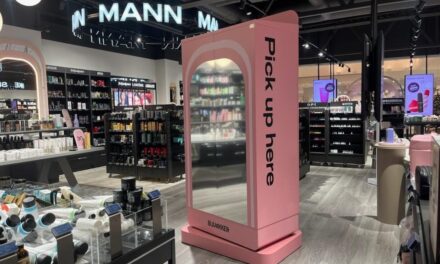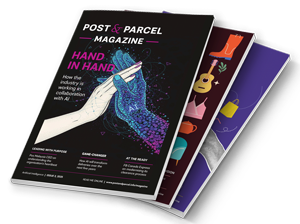
YOUR PERSONAL POST BOX
Online retail has a problem on its hands. The concept has become too successful for its own good. After the UK's third e-Christmas, dominated by the likes of Amazon, it's safe to say that the general public's interest and confidence in shopping online has only increased, despite a corresponding lack of confidence of prospective investors.
In March alone, total online retail sales in the UK rose by 10.4 from #397m in February to #438m, according to the Interactive Media in Retail Group (IMRG). UK online retail sales are now growing at 10 times the rate of traditional retail.
However, with this confidence comes a desire and an impatience to have goods delivered on the customer's terms, not the e-tailer's. This means that the number of ways in which merchants fulfil demand must increase accordingly, adding a new layer of complexity to the process.
One of the fastest growing sectors addressing this issue is the drop- box market. These secure delivery boxes allow goods to be delivered at any time, for consumers to pick up at their convenience.
As the demand for different delivery options rises with customer numbers and expectations, retailers and their delivery partners must now start to use a little imagination in how they dispatch their goods. Until now, the e-tailers' focus has been on the reliability of their fulfilment system, concentrating on faithfully getting the goods to the customer, however long it took. Now the emphasis has to be on flexibility and speed of delivery.
Inconvenience stores
Progress to match fulfilment levels with customer expectations has been rather slow. Although orders tend to reach their destinations eventually, stories of deliveries at a time and place customers are least likely to be contactable still abound.
Some e-tailers are side-stepping this process altogether, taking the risk upon themselves. Virgin Wines, realising the core customers for its service aren't likely to be at home in daytime hours, has launched a delivery guarantee. If customers aren't at home when the delivery is made, the couriers will find a safe place to leave the wine, guaranteeing to "replace it if it gets nicked".
Simon Palethorpe, recently appointed MD of John Lewis Direct, says: "I think the customer is frustrated with delivery at the moment. There haven't been huge developments over the last two years. There has been a lot of talk and there continues to be a lot of talk."
There is a reason for this. At a time when spending on e-commerce projects is in decline, retailers aren't prepared to shoulder the extra costs associated with moving from existing delivery models. However, a trade-off must be made between these and the rising customer acquisition costs that are incurred once shoppers start to lose patience with what's on offer and go elsewhere.
From the retailers' standpoint, they must have leeway to address the myriad concerns that accompany the day-to-day selling and marketing of goods, without disruption by online operations leading to higher fixed costs.
To achieve this, retailers are increasingly farming out that new level of complexity by outsourcing their fulfilment operation. Forrester Research's most recent report on the issue points out that "fulfilment is tough and the economics are getting worse. Retailers must partner with new fulfilment intermediaries, letting them offer competitive delivery options and keep costs under control."
John Lewis is a useful example of how retailers that need to gear up quickly to the challenge of selling online are approaching the matter, given the added complexity inherent in an expanding and heterogeneous customer base. Six months ago, when the retailer relaunched its Web site, it made the decision to farm out fulfilment to iForce, at a cost of around 15% of the revenues from its e-commerce operations.
"Outsourcing has worked well in an environment where we had to be up and running very fast," says Palethorpe. "We were able to build up the site without disruption to our other business."
"The problem with e-fulfilment is that it's more demanding than traditional fulfilment, because customer expectations are higher," adds Mike Trenouth, group commercial director at iForce. "The challenge is technological. You need technology to make sure you have a robust process from retailer to customer."
Tesco, Sainsbury's, Marks & Spencer, French Connection, Dixons, Boots and even pure-play veteran Lastminute.com have opted to keep things simple and less expensive by outsourcing.
Thinking inside the box
At the root of the problem is the issue of delivering to the 'last mile' with greater flexibility. For the customer, this means less rigid delivery times.
According to industry watchers, the future of fulfilment will depend on retailers, via their carriers, investing in a combination of same-day delivery, unattended delivery and local pick-up points. However, reluctant to increase their development budgets, most retailers are placing responsibility for innovation firmly at the door of delivery companies.
This vacuum is now beginning to be filled by forward-thinking delivery firms and a new breed of 'drop-box' manufacturers, offering a mixture of home delivery and pick-up options.
Among those setting the scene is Consignia. Criticised for its name change from The Post Office (to which it'll return within two years) and accused of being a reactive monolith, its approach to the e- fulfilment can't be faulted. In the last 18 months it has put its considerable geographical coverage and brand awareness to use and launched several initiatives to advance flexible delivery.
In addition to its outsourced fulfilment services and ParcelForce Worldwide's limited same-day, 48-hour, weekend and 'timed window' delivery slots, Consignia has introduced an option of delivery to local Post Offices, from where customers can pick up the goods themselves. Called Local Collect, the nine-month-old scheme launched nationwide last September and incorporates 16,000 of the UK's 18,000 Post Offices. E-tailers such as BlackStar, Figleaves and Thornton's pay Consignia #300 a year to list participating Post Offices on their sites.
Last month Consignia added to its fulfilment portfolio with Decide & Deliver, a B2C offering that works in conjunction with Local Collect. The scheme enables online shoppers to provide a list of preferred delivery addresses to the Decide & Deliver database, via the Royal Mail or ParcelForce sites, to be downloaded wherever they're shopping on the Internet. Consumers can then choose to have goods delivered to their home, work, family or any one of the UK Post Office branches when buying from retailers that are part of the Local Collect service.
According to Nigel Moore, marketing director of Consignia's home shopping operation, the move is a direct bid to counter reluctance among retailers to come up with alternatives to delivery that better suit the customers, which is partly responsible for stunting the advance of online fulfilment.
"The last mile is where the consumer is going to drive the market, where retailers will start to make choices available to consumers," he says. "The challenge for the distribution industry is that we can create delivery options. But we must empower consumers to make the choices; ask them what the best options are."
Expanding its options, Consignia has teamed with a number of delivery solution firms, from drop-box manufacturers to drop-off specialists, in a series of pilot schemes to evaluate their viability for unattended deliveries (see box).
From one of the fastest growing, and increasingly overcrowded, sectors of the home delivery market, Consignia chose five drop-box system vendors for its September pilot: BearBox, ByBox, HDA Delivery Point, Homeport and Secure Storage Solutions (3S).
All use varying kinds of drop-boxes that are left at customers' premises or elsewhere for use while they're away, with techniques from one-off PINs to text messaging to guarantee secure delivery. Although still a nascent market, research suggests that because of potential cost cuts, retailers may favour drop-boxes over flexi-time distribution.
According to a survey by the home delivery applications vendor Paragon Systems Software, delivering to people's homes within very tight time windows can account for up to 38% of total home delivery costs. It thinks these figures may persuade e-tailers to resist consumer calls for specific delivery times (which carriers like Consignia advocate) and opt for drop-boxes. Retailers that have done so include Sainsbury's and Streets Online, with Homeport and Giraffe Marketing's delivery boxes respectively.
Setting standards
However, that age-old obstacle to innovation could rear its head in this new sector: a lack of standardisation. The offerings of each drop- box manufacturer have to build in some level of uniformity that will enable the different retailers and carriers to interact with them.
"If a drop-box is to become popular, it has to be an open system so retailers won't need special systems to deliver to customers," says Consignia's Moore. "It has to be simple to operate, with minimal requirements for systems integration. And it must also be marketed as a consumer product."
However, some observers already think there are too many in the sector, even before it has taken off. "Boxes won't be viable if there are more than two firms competing in one area," says Matthew Green, MD of fulfilment consultants Network IT Marketing. "Just as Royal Mail is about to be hit by new operators in its space, so will drop-box manufacturers. As with anything, it seems like a good idea at the start but when 10 or 11 firms are doing it, it no longer is."
Following the inevitable shake-out, Green thinks drop-boxes will only service high-value deliveries. "Generally, customers have no problem with the fulfilment levels that are set by firms like Amazon and BlackStar and have accepted these as the norm. Whether this is good or bad is irrelevant."
But ultimately, who pays for the box: the customer, retailer or carrier? With online UK sales still at just 2.45% of total retail, according to the IMRG, any interest by the consumer would at this stage be insufficient to stimulate demand to any significant level.
Homeport marketing director Mark Lunn agrees. According to research carried out by the box manufacturer, consumers are only willing to pay between #30 and #50 for a drop-box – some way short of the approximate cost of #200. "It's unrealistic to expect a customer to buy a Homeport or a BearBox," he says. "There's a hangover from the idea that everything online should be free. In the short term, retailers have more pressing things to do than invest in drop-boxes."
He also thinks that the future for drop-boxes lies with grocery deliveries, as delivery companies aren't interested in the low-volume transactions for which the drop-box works well. "The carriers didn't get their retail partners on board," he says. "Neither did they want to carry portable boxes around."
Carriers in turn will see ownership as viable only if box costs fall below those of failed delivery, which aren't always easy to pass back to the retailer. Drop-box manufacturers are targeting all three sectors of the market, with some even advocating rental rather than sale.
This might be the point at which retailers and carriers can no longer shy away from charging consumers for the flexibility they want. Verdict Research's 'Home Delivery and Fulfilment 2002' survey found that although the cost of home delivery is important to consumers, their main bugbear is the inconvenience of having to stay in for deliveries.
"If you have the right consumer group prepared to pay for the extra level of convenience, then you don't have to increase your costs," asserts Moore.
"Until we give customers the option to pay, we won't really know," says John Lewis's Palethorpe. "It warrants further investigation and testing."
Of course, there are some glaringly obvious pitfalls to the drop-box model. In many urban areas, clearly the prime target market for the model, housing designs mean there's simply nowhere suitable to locate these boxes.
James Bates is marketing director at BearBox, which is currently completing its first customer trials. It's in talks with manufacturers for commercial roll-out early next year. He ruefully accepts that not all houses and flats are suitable for the drop-box model. However, he claims research carried out by Bearbox suggest that 75%-80% of UK households have available space, admitting that this is skewed slightly towards rural areas.
"Not all households have a garage, for example," he says. "However, even if we can reach only 50% of the UK, that's still a lot of people who will benefit."
Buildings containing multiple flats could also pose problems. Bates says BearBox, along with many of its peers, is creating solutions to counter this. Blocks, for instance, could share a box, with individual security options. For multiple flat dwellings, BearBox plans to offer banks of individual lockers.
Another solution could be found in emerging variations on the home- based drop-box, such as a bank of boxes, which extend the idea into public spaces like train stations and industrial estates, or even further to drop-off and collection points. The latter could be 24-hour garages and convenience stores, already used by the likes of Dropzone1 and Collectpoint. In March, Texaco went into the collections business for itself by launching its RelayStar drop-off service.
Right here, right now
During the dotcom boom, a perceived enthusiasm for instant gratification among some members of the industry spawned a number of one-hour delivery firms, delivering anything from CDs to chocolates. For a while, it looked like they would shake up the same-day delivery landscape. Then, one by one, they began to falter. Urbanfetch, Koobuycity and ZapitOver all died soon after birth. Will the arrival of new delivery options revive interest in one-hour delivery?
"It could be set up in small geographical regions, but you'd need a very local fulfilment centre with a limited range of goods," says Consignia's Moore. "You would have to offer a low level of choice, which goes against the reasons for shopping online in the first place. Same-day delivery however, is a different matter."
Retailers can no longer afford not to address the new demands within home delivery. The instinct to cut spending must give way to pragmatic investment, to keep abreast of demand. If consumers feel they're getting an extraordinary level of service, they would be happy to pay for it. As Moore says, "The moment of truth comes at the doorstep."
Quick Take
* Online sales are growing at 10 times the rate of traditional retail and consumers are increasingly demanding more flexible delivery times.
* Many retailers aren't prepared to shoulder the costs associated with deviating from existing delivery models.
* The fulfilment vacuum is being filled by delivery firms and a new breed of drop-box manufacturers offering a mix of home delivery and pick-up options.
* There's still debate surrounding who should pay for these boxes: the customer, retailer or carrier.
Copyright: Centaur Communications Ltd. and licensors










![Citizens Advice: We continue to see millions of people chasing lost parcels [and] having their accessibility needs ignored](https://postandparcel.info/wp-content/uploads/2020/12/parcels-440x264.jpg)

